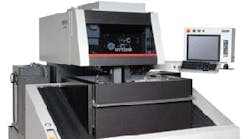The new cylindrical drive technology is described as a “simple yet intelligent design concept” using a linear shaft motor. For comparison, EDMs built on a linear system are a flat-plate design, which limits the effective magnetic flux to only half of its potential. Mitsubishi’s round magnetic shaft creates a non-contact design that uses a full 360 degrees of magnetic flux, so the new design delivers no wear, no cogging (which, the developer noted is “inherent” to flat plate systems), and no backlash. All these factors combine to achieve energy efficiency, accuracy, and speed in operation.
The MV Series is built on a one-piece T-shaped casting, with the X and Y axis ways and drives mounted directly on this base, providing a rigid and thermally stable platform, and driving the table and column independently. This direct-axis mounting style removes all squareness and accuracy issues that come with a stacked table design, the developer noted, providing higher rigidity and smoother movement for more reliable, precise cutting.
A new servo control system uses a fiber-optic drive system with four times the communication speed for improved reaction time and accuracy. The Digital Matrix Sensor and V350 type-V generator specifically shapes the pulse to minimize electrode wear and decrease wire vibration, decreasing wire consumption while maintaining quality and straightness of the cut. The builder refers to tests showing reductions in wire consumption up to 60% over other wire EDM systems, and 40% lower operating costs.
Also, MC Machinery said its redesigned auto-threader concept improves threading capabilities, with upper rollers that travel with the Z-axis, creating a constant distance to the upper guide. This allows nearly 14 inches of annealed wire length, reducing the wire-curl ratio and improving threading reliability on tall parts, and submerged rethreading through the gap in case of a wire break.
The MV Series has new head design with a flat-plate power feeder that uses lever lock system for easier indexing during operation. The operator has no need to open doors to rotate the carbides or realign wire during operation, which contributes significant timesavings to the overall production process.
Finally, the developer noted that the new series incorporates several design improvements to reduce operating costs overall, including a less expensive power feed design; larger wire drive rollers with more useable surface; reduced electrode wear for lower wire cost; optical drive plus LSM for reduced electrical consumption; and a Sleep Mode function that turns off pumps and restarts on schedule, to save energy and keep the machine thermally available for operation.






